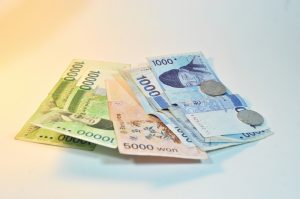South Korea has weathered the pandemic better than nearly every other advanced economy, but financial risks have grown significantly over the past year, according to a new report issued by the country’s central bank. Stressing that the financial market remains stable, the Bank of Korea (BOK) on Tuesday pointed out concerning recent developments that could be the impetus for an interest rate hike in the coming months.
Though it does not come as a shock that many put themselves in a more precarious situation to get through the difficulties of the pandemic, the latest Financially Stability Report importantly provides a clearer picture of South Korea’s overall financial health. One of its key metrics is the BOK’s Financial Vulnerability Index, a composite index ranging from 0 to 100 calculated from 39 indicators. The index increased from 41.9 before the outbreak of COVD-19 to 58.9 through the first quarter of this year. This jump hastens a climb in the index, which started after the Global Financial Crisis, but is below the 73.6 reached during that crisis and the 100 of the Asian Financial Crisis. Still, the BOK claimed that if the index continued to rise to a projected 68.1 by 2024 it could cause the economy to contract by as much as 2.2 percent in the case of a crisis.
Driving this worsening financial vulnerability is a rising private credit-to-GDP ratio, indicative of how leveraged the private sector is. From the same period last year, the ratio grew by nearly 16 percent in the first quarter of 2021, reaching an estimated 216 percent. Although this figure was already relatively high for South Korea before the pandemic – its ratio of 197 percent in 2019 was above the 165 percent average among advanced economies reporting to the Bank of International Settlements (BIS) that year – the pace of the increase stands out. The latest available data from the BIS shows that among 43 reporting countries, South Korea’s nearly 18 percentage point growth in the private credit-to-GDP ratio from the last quarter of 2019 to the same period in 2020 was higher than the group’s average increase of 11 percentage points.
Tracking a year of headlines about dramatically rising home prices in Seoul and corporate borrowing to power through the pandemic, households and businesses were both major contributors to the growth in private debt. Overall household debt increased by 9.5 percent year on year in the first quarter of 2021, with the ratio against disposable income ratio growing by 11.4 percent. Lending to businesses was up by even more at 14.1 percent, but the total size of this debt – 1,402 trillion won ($1.23 trillion) – remains smaller than the country’s 1,765 trillion won ($1.55 trillion) in household debt. By comparison, over the same period South Korean GDP only increased by 3 percent.
The BOK downplayed the immediate threats posed by this debt accumulation, citing mitigating factors such as the resiliency of commercial banks and non-bank financial institutions, the low delinquency rate on household loans, and low short-term external debt relative to official foreign reserves, but still emphasized its longer-term apprehensions. Speaking to the media after the report’s launch, BOK deputy governor Park Jong-seok stated, “The widening gap [between asset prices and real economic growth] needs to be taken into consideration while deciding on interest rate policies,” adding, “there is a need to normalize currently expansionary monetary policies in an orderly manner at the right time.”
These comments align with recent others from BOK officials, suggesting that the central bank is seriously considering raising its key interest rates. While this may help to slow rising asset prices and borrowing rates, it is sure to clash with the government’s continued effort to stimulate the economy. Regardless, with this report the BOK seems to be laying out its case for a rate increase before the end of the year, giving advance notice to businesses and households to prepare for higher borrowing costs.

































